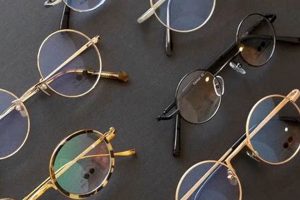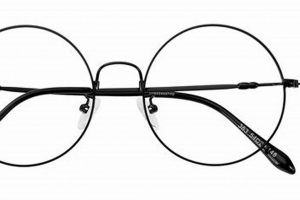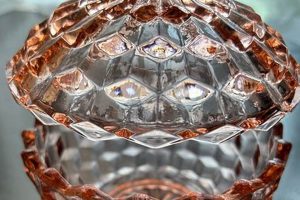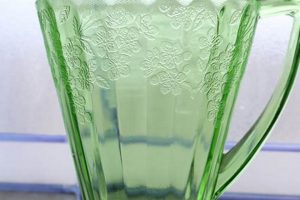This collectible glassware, produced primarily from the late 19th century through the mid-20th century, incorporates uranium oxide into its composition. The presence of this compound imparts a distinctive yellow-green hue, although other colors are possible depending on additional additives. A readily identifiable characteristic is its fluorescence under ultraviolet light, exhibiting a bright green glow. A common example is tableware such as plates, bowls, and drinking glasses, as well as decorative items like vases and figurines.
The appeal of this glassware lies in its aesthetic qualities, its historical significance as a product of specific eras, and the novelty of its radioactive properties. While the levels of radioactivity are generally considered low and not a significant health hazard under normal handling conditions, the awareness of this element adds a unique dimension to its collectibility. Production declined significantly after the Cold War due to restrictions on uranium use, increasing the rarity and value of existing pieces.
The subsequent sections will delve into aspects of identifying authentic pieces, assessing their safety, and understanding the market for these sought-after items. Factors influencing value, such as color, pattern, manufacturer, and condition, will be explored. Guidance on responsible handling and storage will also be provided to ensure the preservation of these historical artifacts.
Tips for Identifying and Handling Vintage Uranium Glass
This section provides crucial guidance for collectors and enthusiasts regarding the identification, safe handling, and preservation of uranium-containing glassware.
Tip 1: Utilize Ultraviolet Light for Identification. A key characteristic is its fluorescence under a UV light source, typically emitting a bright green glow. However, be aware that other substances can also fluoresce, so further examination is often necessary.
Tip 2: Inspect for Characteristic Colors. While the most common shade is a yellow-green, the presence of other metals in the glass composition can result in other colors, such as yellow, green, or even blue. Familiarize yourself with the range of possible colors.
Tip 3: Research Manufacturers and Patterns. Certain manufacturers and patterns are more prevalent. Examining maker’s marks or consulting reference guides can help determine authenticity and value.
Tip 4: Assess Condition Carefully. Cracks, chips, and other damage can significantly reduce value. Examine pieces thoroughly before acquisition. Minor wear consistent with age is generally acceptable.
Tip 5: Understand Radioactivity Levels. While the radioactivity is generally low, it is advisable to use a Geiger counter for verification, especially when dealing with larger collections. Maintain adequate ventilation when storing multiple pieces.
Tip 6: Store Securely. Proper storage is essential to prevent breakage and potential contamination. Keep items away from direct sunlight and extreme temperatures. Handle with care to avoid damage.
Tip 7: Exercise Caution when Handling Food. While occasional use for serving food is generally considered safe, avoid prolonged storage of acidic foods within uranium-containing glassware. The uranium content may leach into the food over time.
Adhering to these guidelines will assist in making informed decisions regarding the acquisition, handling, and long-term preservation of these unique historical items. Prioritizing safety and informed practices will enhance the enjoyment and appreciation of these artifacts.
The subsequent sections will cover legal considerations and ethical aspects surrounding its possession and trade, as well as provide resources for further research and community engagement.
1. Fluorescence
Fluorescence represents a defining characteristic directly linked to the presence of uranium within the glass matrix. The inclusion of uranium oxide in the glass composition results in a specific atomic structure capable of absorbing ultraviolet (UV) light. Upon absorption, the uranium atoms become energized and subsequently release this energy in the form of visible light, predominantly within the green spectrum. This phenomenon, known as fluorescence, provides a relatively simple, non-destructive method for preliminary identification. For example, when a piece of yellow-green glassware emits a bright green glow under a black light, it strongly suggests the presence of uranium. However, further investigation is often warranted to confirm authenticity and differentiate it from other fluorescent materials.
The intensity of the fluorescence can be affected by several factors, including the concentration of uranium oxide, the specific type of UV light employed, and the presence of other elements within the glass. Certain colorants or coatings can either enhance or diminish the effect. The practical application of understanding fluorescence extends to several domains: collectors use it to identify potential acquisitions; researchers employ spectroscopic techniques to quantify uranium content; and museum curators utilize it for authentication and conservation purposes. Properly understanding the nuances of fluorescence also mitigates the risk of misidentification, a common challenge when dealing with similar-looking but non-uranium-containing glass.
In summary, fluorescence serves as a key indicator, attributable to the fundamental interaction between uranium atoms and UV light. While not definitive proof, it forms a crucial part of the identification process. The phenomenon allows for a rapid, initial assessment, complementing more rigorous analytical methods. Challenges remain in differentiating genuine examples from imitations, necessitating a comprehensive understanding of manufacturing techniques and material properties. By emphasizing this interconnectedness, enthusiasts and professionals are better equipped to appreciate and evaluate this historical material.
2. Color Variation
Color variation in this glassware arises from a complex interplay between the uranium oxide component and other metallic oxides introduced during the manufacturing process. These additives deliberately or inadvertently alter the final hue, deviating from the characteristic yellow-green associated solely with uranium. Understanding these variations is crucial for authentication and valuation.
- Influence of Manganese Dioxide
Manganese dioxide, when added to the glass melt, counteracts the yellow tint imparted by uranium, often resulting in a subtle pink or amethyst coloration. This is frequently observed in older pieces where manganese was used as a decolorizing agent to neutralize iron impurities. This unexpected color shift necessitates careful examination when authenticating seemingly atypical specimens.
- Impact of Iron Oxide
Iron oxide, if present in the raw materials, can shift the color towards a deeper green or even a brownish-green. The intensity of the color depends directly on the concentration of iron. This is particularly noticeable in glass produced using less refined materials. Distinguishing between intentionally colored examples and those influenced by impurities is important for accurate assessment.
- Role of Cobalt Oxide
Cobalt oxide, even in minute quantities, produces a strong blue hue, often combined with the uranium’s fluorescence. The resulting color can range from a vibrant turquoise to a more subdued blue-green. This combination commands a premium in the collector’s market due to its relative rarity and aesthetic appeal.
- Effect of lead Content
Higher concentrations of Lead may cause to the vintage uranium glass to appear more yellow, particularly in pieces that have seen considerable use or exposed to enviromental conditons. This is due to Lead oxide’s effect on the fluorescence and refractive properties of the glass
In summary, color variation is not merely an aesthetic characteristic; it serves as a fingerprint reflecting the chemical composition and manufacturing techniques employed during production. Appreciating the nuances of color requires a thorough understanding of glass chemistry and historical production practices. Proper identification involves considering these factors alongside other characteristics such as fluorescence and manufacturer’s marks. Careful assessment is vital for both collectors and researchers to accurately classify and value these unique historical objects.
3. Radioactivity
Radioactivity is an inherent characteristic stemming from the presence of uranium oxide within the glass matrix. This feature, while often misunderstood, is crucial for both identifying and understanding the properties and potential concerns associated with collectible glassware produced with uranium compounds.
- Alpha Emission and External Hazard
Uranium isotopes decay primarily through alpha emission. Alpha particles possess limited penetration ability; they are readily stopped by a sheet of paper or the outer layers of human skin. Consequently, the primary hazard posed by external exposure to uranium-containing glassware is minimal, provided the glass remains intact. Damaged or powdered glass could potentially present an ingestion or inhalation hazard, though the risk remains relatively low.
- Beta Emission and Internal Hazard
Following alpha decay, daughter products within the uranium decay chain undergo beta emission. Beta particles have a greater range than alpha particles, but are still easily shielded. Internal exposure, through ingestion or inhalation of particles, represents a greater concern due to the proximity of the radioactive source to internal organs. However, the quantities involved in typical handling scenarios are considered insufficient to pose a significant health risk, provided appropriate hygiene practices are followed.
- Gamma Emission and Shielding Considerations
The uranium decay chain also emits gamma radiation, a form of electromagnetic radiation with high penetration ability. While the levels are generally low from individual pieces of glassware, prolonged exposure to a substantial collection could warrant consideration of shielding, such as storing the collection in a lead-lined cabinet. Measurements using a Geiger counter can quantify the radiation levels and inform decisions regarding storage and handling.
- Radioactive Decay and Half-Life
Uranium isotopes have extremely long half-lives, measured in billions of years. This means that the radioactivity of this glassware remains virtually constant over human timescales. While the activity level is measurable, the long half-life implies a slow rate of decay and a low radiation output at any given time. This differentiates this collectible from materials containing isotopes with shorter half-lives, which exhibit a more rapid decline in radioactivity.
The low levels of radioactivity associated with this glassware, coupled with the long half-life of uranium, result in a generally low health risk under normal handling conditions. However, understanding the types of radiation emitted and the potential for internal exposure is crucial for informed decision-making. By taking appropriate precautions, enthusiasts can enjoy their collections without undue concern. The next sections address the legal regulations surrounding the possession and trade, further solidifying a foundation of comprehensive knowledge for collectors.
4. Manufacturer
The identity of the manufacturer represents a critical factor in the appraisal and authentication of vintage uranium glass. The production of this glassware was not ubiquitous; rather, it was concentrated among specific glassworks, each with distinct techniques, patterns, and chemical formulations. This imparts a unique fingerprint to each maker’s products. The manufacturer directly influences the rarity, desirability, and therefore, the market value of a piece. For example, a Fenton Glass Company piece, known for its intricate patterns and vibrant colors, commands a higher price than an unmarked, utilitarian item of unknown origin. Recognizing the maker allows historians and collectors to contextualize the piece within broader trends in glassmaking and design.
Furthermore, the manufacturer’s reputation for quality and the survival rate of their products play a significant role. Companies like Vaseline Glass, with their distinctive, high-uranium content glass, or firms known for specific patterns, have established a strong collector base. Understanding the production practices of these companies, including the types of molds used, the range of colors produced, and common identifying marks, is essential for accurately identifying and dating pieces. Access to manufacturer catalogs, archival records, and specialist knowledge significantly aids this process. Identifying the manufacturer, therefore, moves beyond simple labeling; it unlocks a deeper understanding of the object’s history and construction.
In conclusion, the manufacturer provides a crucial link in the narrative surrounding vintage uranium glass. The manufacturer determines material composition, design characteristics, and historical context. Challenges persist when dealing with unmarked pieces, requiring a more detailed analysis of style, technique, and chemical signature to infer origin. Despite these challenges, the identity of the manufacturer remains a cornerstone for assessing value, authenticity, and historical significance within the collectible glassware market.
5. Pattern rarity
Pattern rarity exerts a significant influence on the valuation and desirability of vintage uranium glass. The inherent scarcity of specific patterns, resulting from limited production runs, experimental designs, or short-lived manufacturing periods, elevates their status within the collector market. This is a direct consequence of supply and demand; as the availability of a particular pattern diminishes, its perceived value and collectibility increase proportionally. For instance, a specific pattern produced by a smaller, less prolific glassworks is inherently more valuable than a mass-produced, widely available design, even if both are of similar quality and condition. The presence of unique or intricate motifs further enhances the attractiveness, making them sought-after targets for collectors. Understanding pattern variations and identifying rare designs is, therefore, a critical skill in evaluating vintage uranium glass.
The significance of pattern rarity extends beyond mere aesthetics; it offers insights into the historical context of glass production. Certain patterns may have been commissioned for specific events or periods, rendering them unique historical artifacts. Furthermore, limited production runs often signify innovative or experimental techniques that were subsequently abandoned due to cost or complexity. This makes the patterns not just visually appealing but also indicative of the technological and design evolution within the glassmaking industry. Identifying these details involves detailed research and the use of period catalogs and historical records to understand production volumes and original designs. Without such understanding, there is a danger of overlooking a unique specimen.
In conclusion, pattern rarity significantly enhances the value and historical importance of vintage uranium glass. Understanding the nuances of specific patterns and their production history is essential for effective evaluation and collection. While other factors such as manufacturer, color, and condition also play a role, the scarcity of a particular pattern often serves as a primary driver in determining its market value and historical significance. The effort involved in identifying rare patterns yields increased accuracy in valuation and a deeper appreciation for the history behind the collectible glassware, which serves as a goal in collecting and understanding.
6. Physical Condition
The physical condition of vintage uranium glass directly influences its value, collectibility, and potential safety. Intact pieces, free from significant damage, are considerably more desirable than those exhibiting cracks, chips, or extensive wear. The structural integrity not only affects the aesthetic appeal but also the potential for uranium leaching, albeit minimal in most cases. For example, a pristine uranium glass bowl from the 1930s commands a significantly higher price than the same bowl with a large crack, even if the latter still fluoresces under UV light. Furthermore, damage can compromise the structural stability of the glass, increasing the risk of breakage during handling or display. Therefore, careful assessment of physical condition is paramount for informed collecting and responsible stewardship.
The types and severity of damage also dictate the corrective measures, if any, that can be undertaken. Minor surface scratches may be addressed through specialized polishing techniques, though such interventions can alter the original surface and potentially diminish value if not performed skillfully. Significant cracks or chips, however, are generally considered irreparable, severely limiting the piece’s appeal and functionality. The potential for repair depends on the glass’s specific composition and the nature of the damage. For instance, thin-walled glass is more susceptible to shattering and may be deemed beyond restoration. The condition assessment should also consider the presence of any internal stress fractures, which are often difficult to detect visually but can lead to sudden breakage. Pieces with extensive damage, while potentially of limited monetary value, can still be useful for educational purposes or display in a non-functional context.
In summary, the physical condition plays a pivotal role in determining the value, safety, and historical significance of vintage uranium glass. A thorough inspection to identify any defects is an essential step in the acquisition and long-term preservation of these artifacts. While minor imperfections may be acceptable as evidence of age and use, significant damage substantially reduces desirability and may pose handling risks. The commitment to preservation ensures that vintage uranium glass remains a valuable window into historical manufacturing processes and design aesthetics.
7. Historical context
The production and utilization of vintage uranium glass are deeply intertwined with specific historical periods and technological advancements. Understanding this historical context is essential for comprehending the social, economic, and scientific factors that influenced its creation and subsequent decline. This connection shapes its significance as a cultural artifact and collectible.
- The Rise of Art Nouveau and Art Deco
The late 19th and early 20th centuries, particularly the Art Nouveau and Art Deco movements, witnessed the widespread adoption of uranium glass. The distinctive green hue and fluorescence complemented the stylistic preferences of these eras, which emphasized natural forms, geometric designs, and luxurious materials. Glass manufacturers actively incorporated uranium to achieve these aesthetic goals, resulting in a diverse range of decorative and functional objects.
- Technological Advancements in Glassmaking
The development of more efficient glassmaking techniques, such as machine pressing and automated molding, facilitated the mass production of affordable uranium glass. These advancements allowed manufacturers to create intricate patterns and designs that were previously unattainable, making uranium glass accessible to a wider consumer base. This period marked a peak in its popularity and commercial availability.
- Uranium Availability and Regulations
The ease of access to uranium ore significantly impacted its use in glass production. Prior to the mid-20th century, uranium was relatively unregulated, and its radioactive properties were not fully understood by the general public. However, the advent of the atomic age and increased awareness of radiation hazards led to stricter regulations on uranium use, contributing to a decline in its application in glassmaking.
- Social and Economic Factors
Economic prosperity during the early 20th century fueled consumer demand for decorative and luxury goods, including uranium glass. Its affordability and aesthetic appeal made it a popular choice for middle-class households. However, the economic downturns of the Great Depression and subsequent wartime restrictions further impacted its production and availability. Post-war design trends also favored different materials and aesthetics, leading to a decreased interest in uranium glass.
The intersection of these historical factors underscores the significance of vintage uranium glass as a tangible representation of past eras. By analyzing its production, distribution, and consumption within specific historical contexts, one gains a deeper appreciation for its cultural and technological relevance. The interplay between artistic trends, scientific advancements, regulatory changes, and socio-economic conditions shaped the trajectory of uranium glass, making it a fascinating subject for historical study and collecting.
Frequently Asked Questions About Vintage Uranium Glass
This section addresses common inquiries and concerns regarding the characteristics, safety, and collectibility of glassware incorporating uranium oxide. The information presented aims to provide clarity and dispel misconceptions surrounding this historical material.
Question 1: Is vintage uranium glass dangerous to handle?
The radioactivity emitted by this glassware is generally low and not considered a significant health hazard under normal handling conditions. The primary radiation emitted is alpha, which is easily blocked by skin or clothing. Prolonged, direct contact should be avoided, but occasional handling poses minimal risk.
Question 2: How can vintage uranium glass be identified?
A primary method is observing its fluorescence under ultraviolet (UV) light, typically emitting a bright green glow. The color also tends to be a yellow-green hue, although other colors are possible. Identifying maker’s marks and researching patterns specific to manufacturers known to have produced uranium glass can also aid in identification.
Question 3: Does the color of vintage uranium glass affect its value?
Yes, the color significantly impacts value. While yellow-green is the most common, rarer colors, such as blue or red, command higher prices in the collector’s market. The intensity and clarity of the color also contribute to overall desirability.
Question 4: Is it safe to eat or drink from vintage uranium glass?
While the risk is minimal, prolonged storage of acidic foods in this glassware is not recommended. The acid may leach trace amounts of uranium over time. Using it for occasional serving is generally considered safe, but caution is advised.
Question 5: How should vintage uranium glass be stored?
It should be stored in a secure location, away from direct sunlight and extreme temperatures. Proper storage minimizes the risk of breakage and potential contamination. Displaying the glassware behind glass or in enclosed cabinets also reduces exposure.
Question 6: What factors influence the price of vintage uranium glass?
The price is influenced by several factors, including the manufacturer, pattern rarity, color, physical condition, and historical provenance. Pieces from well-known manufacturers, featuring rare patterns, exhibiting unique colors, and in excellent condition, command the highest prices.
Understanding these aspects of vintage uranium glass enables enthusiasts to appreciate its unique characteristics, handle it safely, and make informed decisions about collecting. The historical significance, combined with its distinctive properties, makes this glassware a fascinating area of study and appreciation.
The concluding sections will discuss the legal considerations surrounding its ownership and trade, as well as resources for further research and community engagement within the collector community.
Conclusion
This exploration has illuminated various facets of vintage uranium glass, emphasizing its identification, historical context, radioactivity, manufacturer influence, pattern rarity, and the crucial role of physical condition in determining value. The inclusion of uranium oxide imparts unique characteristics, most notably fluorescence, which aids in authentication. Understanding the historical backdrop allows for informed appreciation, while awareness of radioactivity, though minimal, promotes responsible handling.
Continued research and diligent preservation efforts are paramount to ensure the longevity of these historical artifacts. Careful handling, secure storage, and informed decision-making regarding acquisition and trade will contribute to the enduring legacy of this distinctive glassware. Further study into manufacturing techniques, pattern identification, and the evolving legal landscape surrounding radioactive materials remains vital for collectors and historians alike.







